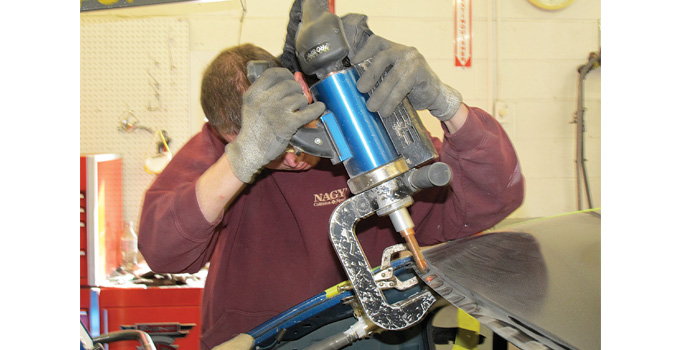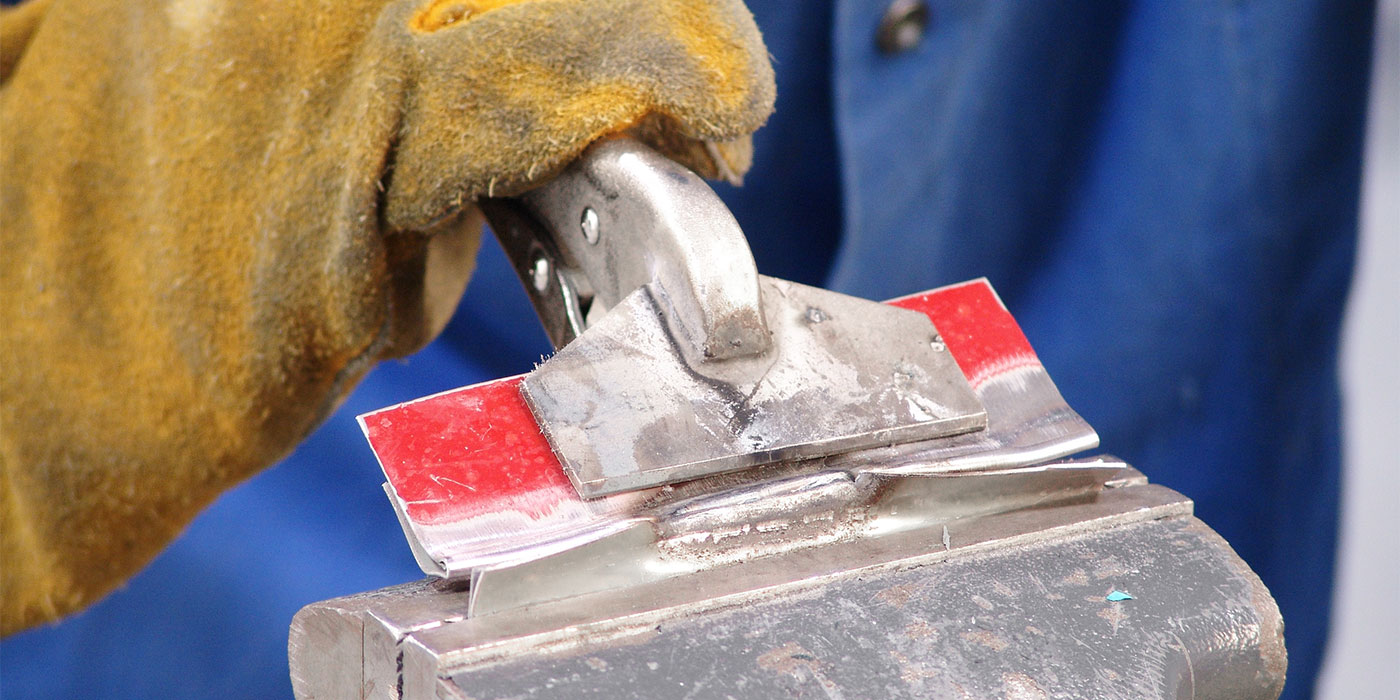
In recent months conducting I-CAR classes, a question keeps popping up: Why can’t we use single-sided spot welds? I’ve heard this question before from techs and managers, but lately I’ve been hearing it more as more shops are using and becoming dependent on squeeze type resistance spot welding (STRSW). Shops that have purchased these welders have found that they’re faster, cleaner and make money for them. The slower plug weld process has been replaced by better and more powerful spot welders. Don’t get me wrong, we still need to plug weld in many situations, but techs have found STRSW to be much faster and more consistent in that there are no holes to drill or dressing to be done. So why is single-sided spot welding not approved?
Not Allowed » To answer the question, I will make a simple statement: most vehicle manufacturers do not allow single-sided spot welding to be used as it does not meet the strength requirements of a structural weld. If the car manufacturer has published a statement allowing the use in certain repairs, then it’s allowed.
It seems simple as a statement, but there is more to the answer. First, as an I-CAR instructor, I will always defer to manufacturer procedures. But the statements don’t tell you “why” it is not recommended. I-CAR has gone the extra mile in the new classes to provide manufacturer procedures in classes but also to answer why we conduct certain procedures. I-CAR’s WCS04 class answers and explains STRSW technology and uses.
STRSW Basics » I understand why techs want to do single-sided spot welds. For example, a technician doing STRSW is replacing a panel and gets to where he does not have access to both sides for the welder electrodes. Now he must resort to an alternative such as a plug weld with steel or a MIG braze weld required by some vehicle manufacturers, which requires more time and prep than doing STRSW. It would be easier and take less time if he could switch and use a single-sided spot weld. Many of the new machines have that feature on them. I can see where it would be tempting. The weld will look similar to the STRSW, but…that’s the issue. It may look good, but it isn’t the same.
STRSW is a structural weld. In simple terms, when the electricity is going through the metal, it creates resistance and thus causes heat. This heat melts the steels, and the pressure of the electrodes pushes the molten metal together to form the weld nugget. This pressure and the resistance created by the high amperage electricity between the electrodes is controlled and uniform so as to not have an arcing effect in the weld zone that would cause metal blowout and contamination in the weld itself. This arcing is why fit-up of metal is so critical to STRSW. Failure to get good metal fit-up will cause a variety of issues that will cause the weld to fail by either lack of penetration or strength, porosity or contamination. With the new three-phase or higher power spot welders, STRSW is consistent in producing high quality welds and duplicating manufacturer procedures. The power and speed at which the weld occurs with the new technologies prevents damaging of the surrounding metal.
Past vs. Present » A single-sided spot weld does not create the same strength as STRSW for a number of reasons, strength being a major concern. Without pressure from both sides, the penetration of metal combining is much lower. This does not allow a proper size nugget to form. The size and penetration is basically the strength of the weld. To see this demonstrated, take two pieces of steel and do a one-sided weld. Then, do a peel test. The top piece of steel should tear a hole, leaving metal on the bottom as an STRSW weld does. You do not see this consistently when doing a destructive test of a single-sided weld.
When doing destructive testing, always weld using actual or similar metal. Although it’s a cosmetic repair, you need to be sure the metal being tested is the same as for the repair being done. To use anything else is an apples-to-oranges comparison.
The other part of strength is caused by a limitation of power at times. On a single-sided weld, the electrode and ground must be on opposite panels to work. The panel fit-up may be complete, but contact may be limited. Even with a technician pushing on the electrode, enough pressure to push the metal together may not occur, which causes arcing to occur between the panels. Although there may be some contact and melting of metal, the strength is severely compromised. Another result of arcing is contamination by the rapid heating of the air and elements in metal, contaminating the area and causing porosity in the weld and a corrosion hot spot.
Another concern is the corrosion of the weld. Because of the gaps and lack of ability to control arcing during the weld, corrosion is a possibility. This could lead to complications and failure later down the road.
This is a short list of issues that may happen while trying to use a single-sided weld. If the work to be done is purely cosmetic, the use of this type of weld may have some benefits. Discipline will be required to do all steps correctly. Please remember that to do single-side welds is a business decision that brings all liability to you.
New Technologies » New technologies in welders have me rethinking some of the aforementioned drawbacks. Today’s welders have a much better current control than past versions. They obviously have a great deal more power, too. This can make the process more viable. With better heat comes more strength to the weld, along with consistency.
Please note: If a vehicle manufacturer calls for specific welds to be done in a repair process, we as repair professionals must follow their procedures. In the absence of instructions, if you make the business decision to use this welding process, please be sure to verify, check and validate a test weld before doing so. In no circumstances should this type of weld be used to replace a structural weld.













